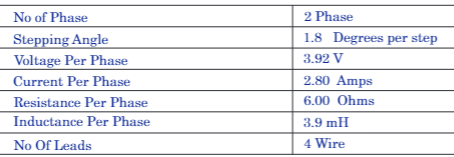I’m facing the same issue with the High power stepper motor driver 36V4.
Could anyone help me with this issue?
Motor Specifications
 ![image|454x157]
![image|454x157]
Power supply rating - 24Volts 4.5A - constant voltage SMPS
stepper driver: Pololu High-Power Stepper Motor Driver 36v4
Following is the connection diagram
I’ve tried both the basic stepping and SPI-stepping examples suggested on the Pololu website
I’m mostly worried because the stepper is not receiving any power.
I’d previously worked with TB67S128FTG and had no problems at all.
Please help me with this issue. And let me know if I’m missing something
Hello.
I moved your post to its own thread so we can troubleshoot it separately. The first thing I noticed about your wiring digram is that you are not connecting to the SPI pins (SDATO, SDATI, and SCLK). The High-Power Stepper Motor Driver 36v4 must be configured through SPI each time it is powered up, so you will need these connections (although the SDATO pin is only needed if you want to read information back from the stepper driver).
Can you connect those pins to the appropriate pins on your Arduino board and try running the examples again? If that does not fix the problem, can you post some pictures of your actual setup that show all of your connections? Also, please specify which particular Arduino-compatible board you are using.
Brandon
Thank you for your suggestions.
These changes worked for me. And the motor is running smoothly.
Coil voltage is found to be 4V with respect to GND. whereas supply voltage is 24V
I want to operate the stepper at a higher voltage and lower current to avoid heating of motor as well as the driver. Is there any parameter or function that I should use to tune the coil voltage?
Please advice
Thank you
You can set the current limit to an appropriate value and the driver will adjust the output voltage as needed through the stepping cycle. The stepper motor specifications in your previous post list the rated current per phase as 2.8A, so you should set the current limit no higher than that. You can set the current limit using our library with the setCurrentMilliamps36v4(); function. For example, in both of our example programs sd.setCurrentMilliamps36v4(1000); is called in the setup() function to set the current limit to 1A per phase; you would change it to sd.setCurrentMilliamps36v4(2800); to set it to 2.8A per phase.
Please note that many electronics and electromechanical components are rated for operation at temperatures well above what would be comfortable to touch (over 100°C). You can set the current limit lower than what your motor is rated for, which will allow it to run cooler, but will also limit the speed and torque it is capable of.
Depending on your application, it might be useful to raise the current limit temporarily (e.g. when you need more torque or speed) and reduce it afterward to prevent heat build-up.
Brandon
 ![image|454x157]
![image|454x157]
